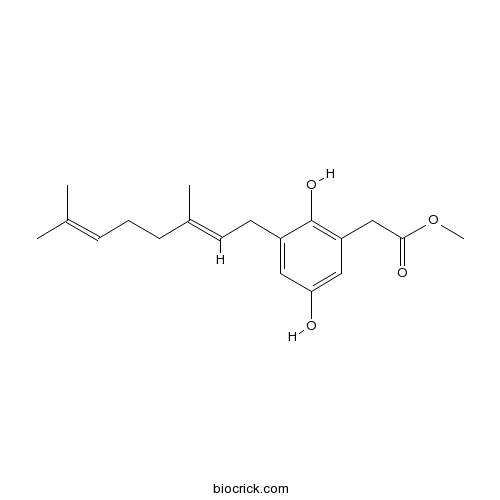DenudaquinolCAS# 1189105-40-5 |

Quality Control & MSDS
3D structure
Package In Stock
Number of papers citing our products

| Cas No. | 1189105-40-5 | SDF | Download SDF |
| PubChem ID | 102025310 | Appearance | Powder |
| Formula | C19H26O4 | M.Wt | 318.41 |
| Type of Compound | Phenols | Storage | Desiccate at -20°C |
| Solubility | Soluble in Chloroform,Dichloromethane,Ethyl Acetate,DMSO,Acetone,etc. | ||
| Chemical Name | methyl 2-[3-[(2E)-3,7-dimethylocta-2,6-dienyl]-2,5-dihydroxyphenyl]acetate | ||
| SMILES | CC(=CCCC(=CCC1=CC(=CC(=C1O)CC(=O)OC)O)C)C | ||
| Standard InChIKey | FJFOYRHXOZSRFV-RIYZIHGNSA-N | ||
| Standard InChI | InChI=1S/C19H26O4/c1-13(2)6-5-7-14(3)8-9-15-10-17(20)11-16(19(15)22)12-18(21)23-4/h6,8,10-11,20,22H,5,7,9,12H2,1-4H3/b14-8+ | ||
| General tips | For obtaining a higher solubility , please warm the tube at 37 ℃ and shake it in the ultrasonic bath for a while.Stock solution can be stored below -20℃ for several months. We recommend that you prepare and use the solution on the same day. However, if the test schedule requires, the stock solutions can be prepared in advance, and the stock solution must be sealed and stored below -20℃. In general, the stock solution can be kept for several months. Before use, we recommend that you leave the vial at room temperature for at least an hour before opening it. |
||
| About Packaging | 1. The packaging of the product may be reversed during transportation, cause the high purity compounds to adhere to the neck or cap of the vial.Take the vail out of its packaging and shake gently until the compounds fall to the bottom of the vial. 2. For liquid products, please centrifuge at 500xg to gather the liquid to the bottom of the vial. 3. Try to avoid loss or contamination during the experiment. |
||
| Shipping Condition | Packaging according to customer requirements(5mg, 10mg, 20mg and more). Ship via FedEx, DHL, UPS, EMS or other couriers with RT, or blue ice upon request. | ||
| Description | 1. Denudaquinol shows cytotoxicity against the SFME and r/mHM-SFME-1 cell lines. |

Denudaquinol Dilution Calculator

Denudaquinol Molarity Calculator
| 1 mg | 5 mg | 10 mg | 20 mg | 25 mg | |
| 1 mM | 3.1406 mL | 15.703 mL | 31.406 mL | 62.8121 mL | 78.5151 mL |
| 5 mM | 0.6281 mL | 3.1406 mL | 6.2812 mL | 12.5624 mL | 15.703 mL |
| 10 mM | 0.3141 mL | 1.5703 mL | 3.1406 mL | 6.2812 mL | 7.8515 mL |
| 50 mM | 0.0628 mL | 0.3141 mL | 0.6281 mL | 1.2562 mL | 1.5703 mL |
| 100 mM | 0.0314 mL | 0.157 mL | 0.3141 mL | 0.6281 mL | 0.7852 mL |
| * Note: If you are in the process of experiment, it's necessary to make the dilution ratios of the samples. The dilution data above is only for reference. Normally, it's can get a better solubility within lower of Concentrations. | |||||

Calcutta University

University of Minnesota

University of Maryland School of Medicine

University of Illinois at Chicago

The Ohio State University

University of Zurich

Harvard University

Colorado State University

Auburn University

Yale University

Worcester Polytechnic Institute

Washington State University

Stanford University

University of Leipzig

Universidade da Beira Interior

The Institute of Cancer Research

Heidelberg University

University of Amsterdam

University of Auckland

TsingHua University

The University of Michigan

Miami University

DRURY University

Jilin University

Fudan University

Wuhan University

Sun Yat-sen University

Universite de Paris

Deemed University

Auckland University

The University of Tokyo

Korea University
- Lettowienolide
Catalog No.:BCN8038
CAS No.:1189105-39-2
- Fmoc-D-Allo-Ile-OH
Catalog No.:BCC3508
CAS No.:118904-37-3
- Alstoyunine E
Catalog No.:BCN4782
CAS No.:1188932-15-1
- CEP-32496
Catalog No.:BCC1079
CAS No.:1188910-76-0
- KN-93 Phosphate
Catalog No.:BCC5638
CAS No.:1188890-41-6
- ABT 702 dihydrochloride
Catalog No.:BCC5905
CAS No.:1188890-28-9
- NBQX
Catalog No.:BCC6624
CAS No.:118876-58-7
- Anti-Inflammatory Peptide 1
Catalog No.:BCC1006
CAS No.:118850-71-8
- Ustusolate C
Catalog No.:BCN6755
CAS No.:1188398-15-3
- Ustusol C
Catalog No.:BCN6757
CAS No.:1188398-13-1
- 15,16-Di-O-acetyldarutoside
Catalog No.:BCN6071
CAS No.:1188282-02-1
- 16-O-Acetyldarutigenol
Catalog No.:BCN6070
CAS No.:1188282-01-0
- Balanophonin
Catalog No.:BCN6072
CAS No.:118916-57-7
- 5-(3-Hydroxypropyl)-7-methoxybenzofuran
Catalog No.:BCN1606
CAS No.:118930-92-0
- 1,3-Dihydroxy-4-methoxy-10-methylacridin-9(10H)-one
Catalog No.:BCN1605
CAS No.:1189362-86-4
- (S,S)-2,6-Bis(4-isopropyl-2-oxazolin-2-yl)pyridine
Catalog No.:BCC8402
CAS No.:118949-61-4
- Ethyl ganoderate J
Catalog No.:BCN3486
CAS No.:1189555-95-0
- Mephedrone hydrochloride
Catalog No.:BCC6183
CAS No.:1189726-22-4
- Fumitremorgin C
Catalog No.:BCC7507
CAS No.:118974-02-0
- 1-O-Deacetyl-2alpha-hydroxykhayanolide E
Catalog No.:BCN1604
CAS No.:1189801-51-1
- Viscumneoside III
Catalog No.:BCN7698
CAS No.:118985-27-6
- 8-Amino-2-naphthalenesulfonic acid
Catalog No.:BCC8783
CAS No.:119-28-8
- Methyl salicylate
Catalog No.:BCN5372
CAS No.:119-36-8
- 7-Anilino-4-hydroxy-2-naphthalenesulfonic acid
Catalog No.:BCC8777
CAS No.:119-40-4
New cytotoxic phenolic derivatives from matured fruits of Magnolia denudata.[Pubmed:19270419]
Biosci Biotechnol Biochem. 2009 Mar 23;73(3):726-8.
Magnolia species are widely cultivated in Japan as garden plants, and have been found to contain various compounds, including alkaloids, terpenoids, lignans, and neolignans. The constituents of the mature fruits of M. denudata were investigated, and two new phenolic derivatives, named denudalide and Denudaquinol, were isolated and characterized, together with a known neolignan compound (denudatin A). Denudalide and Denudaquinol showed cytotoxicity against the SFME and r/mHM-SFME-1 cell lines.


